Abstract
The strategy to adopt for the development of a new lipstick formula requires, as a first step, the definition of the most important characteristics of a modern product. Successively, the identification of the key properties of any innovative ingredient is necessary. Then, a comprehension of the key parameters in the establishment of a stable equilibrium among the different formula components in the solid state is important. Moreover, it is necessary to study the interactions among the new ingredients and the other structural components in the formula. Finally, an evaluation of the sensory properties of the different final formulae for fine-tuning of practical performances needs to be carefully carried out. In this study, a systematic formulation approach tried to obtain a new lipstick formula using a new vegetal-derived emollient *(INCLUDING COCO-CAPRYLATE/CAPRATE, HYDROGENATED OLIVE OIL UNSAPONIFIABLES) with sensorial properties similar to some types of silicones. Some application trials of the new raw material were carried out. The following aspects of this ingredient were investigated: (1) Compatibility and thickening with waxes, (2) dispersion power of pigments, and (3) influence on sensory characteristics of the formulated lipstick. This new emollient has been shown to improve some aspects of a lipstick formula, in particular shine, homogeneity, and covering effect. The optimization of the formula, in order to increase the sensation of softness on the lips, is described. *Plantasens Olive LD SP ECO, supplier Clariant Gmbh.
1. Introduction
1.1. Lipstick Formula—Key Requirements
As for with makeup products, the main aim of a lipstick formula is to release a colored layer, in this case onto the lips, with a simple and soft application. Even if a fair stick softness during distribution is required, an adequate mechanical resistance during application onto the lips should oppose the bending forces involved in this process. The colored trace must be homogeneous, continuous, without oil stripes (the so-called ‘motorboat effect’), hiding the wrinkles of the lips as much as possible. Moreover, the pigmented layer should stay on the lips pseudo-mucosa, and keep stable for hours in spite of the continuous movements and friction of the lips, not bleeding or diffusing by capillary forces along the wrinkle paths. The layer must be plastic and elastic in order to follow the skin’s movements, be water and saliva resistant, not staining easily surfaces that might came into contact with the lips [1]. Safety for the lips and after ingestion must be granted. Shape stability of the stick over time and at different temperatures, even following transportation in a handbag, is necessary. ‘Sweating’ droplets of oil on the surface should not appear, even in adverse conditions. Detachment from the holding support of the lipstick case must be absolutely avoided.
As the stick surface is continuously exposed to atmospheric oxygen, the formula’s ease of rancidity should be minimized. Microbial contamination is highly unlikely in case of anhydrous formulae; nevertheless, the exposed external layer should not support microbial proliferation following contact with the lips and their resident microflora [2,3].
1.2. Basic Ingredient Structure of a Lipstick
The indicative composition of a lipstick is described in Table 1.

Table 1.
Average composition of a lipstick formula, by ingredients.
Stable equilibrium among different types of substances is quite a delicate issue. Starting from the key ingredients, the waxes’ lattice provides most of the structural and layering properties of a lipstick formula. In a strict chemical sense, waxes are esters of long chain fatty acids with long chain fatty alcohol, but under a cosmetic definition, the term waxes usually also includes long chain hydrocarbons, as for instance, microcrystalline or polyethylene waxes. The common factor are their ‘waxy’ characteristics, like high melting point, resistance to friction, layering effect, and chemical and thermal stability. All these are little polarity ingredients, with limited compatibility with polar oils and insufficient wetting power for the pigments’ surface, that is usually medium to very polar. Butters or medium melting point pastes are used to influence the crystalline structure after cooling and provide a continuum of melting points and viscosity among waxes and fluid oils. Oils, in lipstick recipes, have a double function. Firstly, they are used to prepare highly viscous suspensions of thoroughly micronized pigments, keeping solid particles well separated and avoiding aggregation and sedimentation after wet-milling. Then, oils are used to make the crystalline lattice of waxes softer and plasticky, providing ease of distribution over the skin, and controlling shine and softness of the applied layer [4,5]. As a consequence, the first step when testing a new oil additive is to verify its compatibility with common lipstick waxes. Successively, the oil’s capability toward pigment dispersion needs to be analyzed. Then, all the sensorial, stability, and mechanical events after introduction in the whole formula, as substitute of traditional oil, have to be checked.
2. Materials and Methods
COCO-CAPRYLATE/CAPRATE AND HYDROGENATED OLIVE OIL UNSAPONIFIABLES is a vegetal-derived emollient. Its sensorial properties in the skincare field show large similarities to the most commonly used silicones.
At room temperature, it is a clear liquid, with a pale yellow color and faint, characteristic odor. All the other formulation ingredients are commonly used in lipsticks. The list of these ingredients is described in Table 2.

Table 2.
Key raw materials, commercial names, suppliers, and INCI.
2.1. Compatibility Trials with Waxes
Compatibility trials have been carried out, both with vegetable and non-vegetable waxes (Table 3) commonly used in lipsticks, following the same procedure.

Table 3.
Waxes commonly used in lipsticks.
The trial procedure implies weighing the selected key wax at two different concentrations: 10% and 25% into the new oil, then heating the blend to the temperature required to dissolve the wax, under stirring, until a complete solution. The next step is cooling slowly to room temperature, while stirring. In lipstick formulae, different types of waxes are frequently used in the blend, in order to obtain a more mechanically resistant solid lattice at room temperature. Therefore, the behavior of the new oil in blends of three different waxes was also verified, for a total amount of 15%; each wax was used at 5%. Viscosity was measured at 25 °C. Values are taken at three speeds (2.5, 5, and 10 rpm), by using the Viscosimeter Brookfield RVT (AMETEK GmbH/B.U. Brookfield, Hadamar-Steinbach, Germany), with Helipath Stand or standard Spindles.
2.2. Dispersion of Pigments
The study is carried out in order to verify the ability of coco-caprylate/caprate and hydrogenated olive oil unsaponifiables to wet pigments, in comparison to castor oil, which is commonly used for the dispersion of pigments and lakes in makeup products.
The chosen mineral pigments and lakes commonly used in makeup products are:
- Uncoated Titanium Dioxide (HOMBITAN FF)
- Uncoated Zinc Oxide (Z-COTE)
- Brown Iron Oxide (UNIPURE LC 887), a blend of black, red, and yellow iron oxide
- Red Lake (D&C Red N7 Calcium Lake)
Dispersions at 40% solid load were made for the pigments, and at 25% for the lake.
Dispersions were homogenized at room temperature for 10 °C at constant speed (4000 rpm with Silverson L4R turboemulsifier, Silverson Machines Ltd., Chesham, UK). Then they were observed under a microscope, after adequate dilution.
2.3. Technical Parameters of Formulas
The following chemico–physical parameters were verified on the obtained blends and lipstick formulas:
- Viscosity with Brookfield RVT Viscosimeter (AMETEK GmbH/B.U. Brookfield, Hadamar-Steinbach, Germany), with Helipath stand/standard Spindles;
- Microscopic structure with optical microscope (Optika M-699, OPTIKA S.r.l., Ponteranica, Italy) and 300× magnification;
- Drop point measured with the Ubbelhode termometer;
- Determination of breaking load, by applying weights to the lipstick.
3. Results of the Application Trials
3.1. Compatibility with Waxes
These trials allowed to understand the compatibility of coco-caprylate/caprate and hydrogenated olive oil unsaponifiables with vegetable and non-vegetable waxes and how they can influence its viscosity at two different concentrations: 10% and 25%. The operation procedure is described in Paragraph 2.1. The viscosity values of the obtained blends at 10% of waxes are reported in the following table (Table 4).

Table 4.
Viscosity values of the new oil containing 10% waxes at T0.
After 24 h, all the gels obtained showed homogeneous appearance. After 2 weeks, gels with 10% Copernicia Cerifera Cera, hydrogenated vegetable oil, and Olea Europaea oil unsaponifiables showed evident syneresis. Below, the viscosity values measured of oil solutions with 25% wax at T0, after 24 h and after 3 months, kept at room temperature, are shown in Table 5. A gel with 25% Copernicia Cerifera Cera shows an uneven appearance. It is evident that the new oil offers a good combination of rheological effects at a fairly high concentration of waxes, even if in some cases, a good thickening effect was also observed at 10% wax.

Table 5.
Viscosity values of the new oil blended with 25% waxes at T0, T24 h, and after 3 months.
The viscosity of most blends remained almost stable after three months in samples kept at room temperature. A significant increase with time was observed for Candelilla and Copernicia Cerifera waxes. With Stearyl Dimethicone, no increase in viscosity was observed from 10% to 25%.
No syneresis was observed in any gel at 25% waxes, both after 24 h or 3 months.
Viscosity of the blends remained almost stable after three months at room temperature. The figures below summarize and highlight the most interesting data:
- Influence of the most compatible waxes at 10% and 25% on the viscosity of the new oil (Figure 1);
 Figure 1. Viscosity values at 2.5 rpm for the most compatible waxes at 10% and 25% at T0 (at 0.5 rpm for 25% Candellila Cera).
Figure 1. Viscosity values at 2.5 rpm for the most compatible waxes at 10% and 25% at T0 (at 0.5 rpm for 25% Candellila Cera). - Viscosity trends over time for gels with 25% waxes (Figure 2).
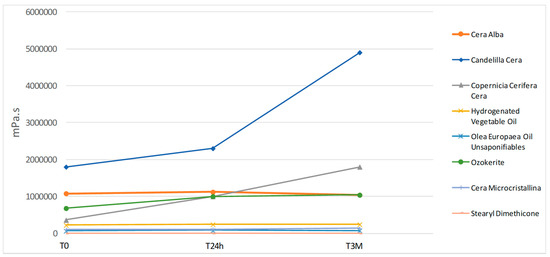 Figure 2. Trend of viscosity values at 2.5 rpm of 25% wax in oil gels at T0, T24, and after 3 months (at 0.5 rpm for Candelilla Cera).
Figure 2. Trend of viscosity values at 2.5 rpm of 25% wax in oil gels at T0, T24, and after 3 months (at 0.5 rpm for Candelilla Cera).
3.2. Compatibility with Ternary Blends of Waxes
As with makeup formulations, frequently, blends of different waxes are used in order to obtain increased mechanical properties [6]. Compatibility tests were thus carried out with blends of three different waxes. Each wax was used at 5%, for a total amount of 15%. Below are the viscosity values measured for each blend at T0, after 24 h and 3 months at room temperature (Table 6 and Figure 3).

Table 6.
Viscosity values of the new oil with blends of three waxes at T0, T24 h, and after 3 months.
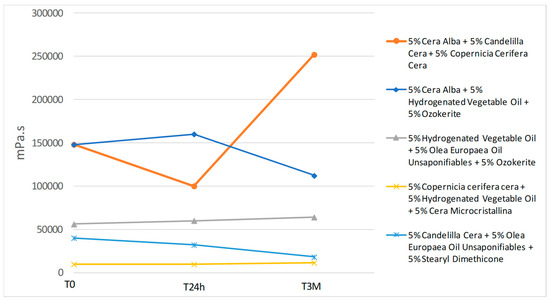
Figure 3.
Trend of viscosity values at 2.5 rpm of blends waxes in oil at T0, T24 h, and after 3 months.
Each blend proved to be stable over time: gels showed no syneresis or uneven appearance. The first blend composed of 5% Cera Alba + 5% Candelilla Cera + 5% Copernicia cerifera Cera showed a viscosity increase after 3 months at room temperature; on the contrary, the one made up of 5% Candelilla Cera + 5% Olea Europaea Oil Unsaponifialbes + 5% Stearyl Dimethicone showed a viscosity decrease.
3.3. Dispersion of Pigments
The ability of the new oil to wet pigments was verified, having castor oil as a benchmark reference oil, commonly used for the dispersion of pigments and lakes in lipsticks for its high polarity, relative stability, and high pigment wetting power. Moreover, castor oil works as a coupling agent between non-polar waxes and polar oils [7]. Uncoated titanium dioxide, brown iron oxide, blend of black, red, and yellow iron oxides; Red Lake (D&C Red N7 Calcium Lake), representing the two categories of pigments used in lipsticks, i.e., oxides and lakes, were selected. Dispersions at 40% solid load were prepared for the oxide pigments, at 25% for the lake. They were homogenized at room temperature for 10 °C at constant speed (≈4000 rpm) in order to break the pigment agglomerates [8]. Dispersions were observed under a microscope, after adequate dilution with the dispersing oil. As an explanatory example of the wetting properties of coco-caprylate/caprate and hydrogenated olive oil unsaponifiables, the dispersions of 40% titanium dioxide in castor oil and in the new oil are shown in comparison (Figure 4).
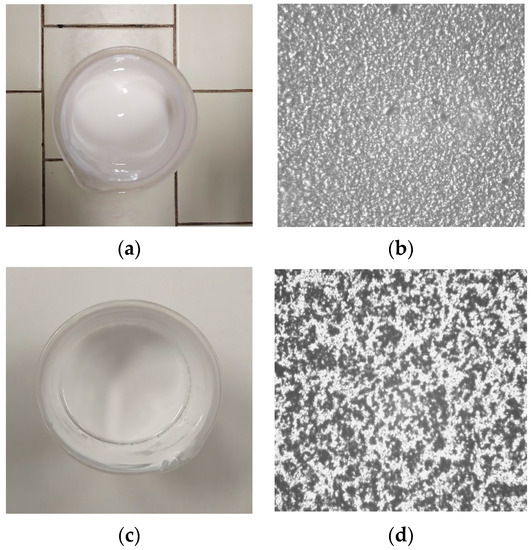
Figure 4.
(a) 40% TiO2 in castor oil; (b) TiO2 dispersion in castor oil after 50% dilution (300×); (c) 40% TiO2 in Plantasens Olive LD SP ECO; (d) TiO2 dispersion in Plantasens Olive LD SP ECO after 50% dilution (300×).
The microscope observation revealed that the dispersion in castor oil is more homogeneous, with smaller agglomerates. Trials repeated with the selected iron oxides and the lake (not shown) presented similar behaviour. Therefore, it was concluded that the oil under examination was not better than castor oil for the dispersion of pigments.
4. Lipstick Formulation
The final aim of this study is to create an anhydrous lipstick formula using a new vegetal-derived oil in combination with other raw materials used in lipsticks. For this purpose, a simple starting model formula was chosen, whose chemico–physical characteristics and stability are known (Table 7).

Table 7.
Initial lipstick formula (Ref.11/21/1).
Key features of this formula:
- Pigments dispersed in castor oil;
- Total amount of waxes: 18% including polyethylene wax;
- Orange-red color, with a semi-gloss finish;
- Drop point: 66 °C;
- Breaking load at room temperature: 200 g.
4.1. The Importance of Oils: Formulation Trials
The first change made to the base formula, concerning the fluid ingredients, was the introduction of the trial oil as replacement of, alternatively (Table 8):

Table 8.
Lipstick formulae with the new oil substitution.
- 10% Castor Oil (Ref.1/21/1A)
- Octyldodecyl Ricinoleate (Ref. 1/21/1B)
- Limnanthes Alba Seed Oil, Butyrospermum Parkii Butter Extract (Ref. 1/21/1C)
- Drop point: 64 °C, Breaking load: 140 g (Ref. 1/21/1A)
- Drop point: 64 °C, Breaking load: 182 g (Ref. 1/21/1B)
- Drop point: 66 °C, Breaking load: 163 g (Ref. 1/21/1C)
The replacement of 10% of castor oil caused a significant reduction in the breaking load.
Moreover, this change worsened the homogeneity of the trace on the skin, compared to the starting formula. Reference 1/21/1B, where the trial oil replaces Octyldodecyl Ricinoleate, the formula showed better spreading properties. This change makes application easier, leaving a brighter mark, with very good covering characteristics (Figure 5).
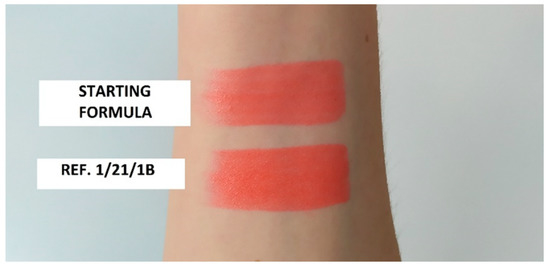
Figure 5.
Trace of Starting Formula vs. Ref. 1/21/1B.
4.2. Further Improvements
Successively, additional changes were made to the formula in order to try and obtain further fine improvement of the application results. Changes made are here described by distinguishing some categories of ingredient:
- Oils and soft-solid lipids
- Waxes
- Active ingredients
(a) Oils and soft solid lipids
Oils and soft lipids contribute to easier spreading, softness, trace brightness and shine. As a model for oil replacement, the trial replacement concerns C10-30 Cholesterol/Lanosterol Esters, an emollient with a soft solid firmness that exhibits excellent spreading ability and provides good adhesion properties to anhydrous lipsticks. For testing purposes, we selected the blend Ricinus Communis Seed Oil, Hydrogenated Castor Oil, Copernicia Cerifera cera. This moisturizing mixture shows similar hydration and occlusion profile to petrolatum, having good softening effect and spreading properties [9]. The obtained lipstick has a drop point of 66 °C and a breaking load of 198 g. A greater covering effect was observed with this modification.
(b) Waxes
The total amount of waxes in the formula is 18%. Below are their melting points (Table 9).

Table 9.
Melting points of waxes contained in the formula.
First change: Replacement of 5% Cera Alba with Hydrogenated Vegetable Oil, with a melting point of 62–72 °C. The resulting lipstick has a melting point of 67 °C and a breaking load of about 171 g.
Then, we tried to replace 6.5% Candelilla Cera with Olea Europaea Oil Unsaponifiables: the result has a lower melting point (45–56 °C) and the lipsticks obtained had too soft a structure. The percentage of this last wax was therefore reduced to increase that of Ozokerite.
In order to reduce the ingredients of synthetic origin, Polyethylene wax replaced by Copernicia Cerifera Cera, which has an equally high melting point (81–86 °C). However, it was necessary to increase the percentage of Copernicia Cerifera Cera to 3.5% to obtain lipsticks with adequate mechanical resistance [10]. Table 10 shows the blend of waxes selected. The total amount of waxes is now 19%.

Table 10.
Selected wax blend.
The lipsticks so obtained have a melting point of 68 °C and a breaking load of 220 g.
(c) Active ingredients
The so-called ‘active ingredients’ in a lipstick are ingredients which provide additional benefit to the skin during the long stay of the trace onto the skin. They have been selected in order to obtain moisturizing and firming properties (Table 11 and Table 12) [11,12]:

Table 11.
Selected active ingredients.

Table 12.
Final lipstick formula Ref. 1/21/18.
Below, is the final formula created (Formula 1/21/18) with its manufacturing method.
Manufacturing method:
In appropriate equipment, pre-disperse and mill lakes and pigments in castor oil. Heat phase A to 85 °C while mixing. In two separate vessels, heat phase B to 95 °C and phase C to 85 °C while mixing.
Add phase C to phase B while mixing. Then add phase B + C to phase A and keep the temperature constant to 85 °C. Add ingredients D, E and phase F just before casting into molds at 80 °C.
Chemico-physical parameters of the formula after 24 h at room temperature:
Drop point: 68 °C; Breaking load: 210 g. The formula proved stable after 2 months in glass jars and in plastic case at room temperature, 4 °C, and 42.5 °C.
The final formula has a greater covering effect than all previous experiments, with a more homogeneous mark (Figure 6).
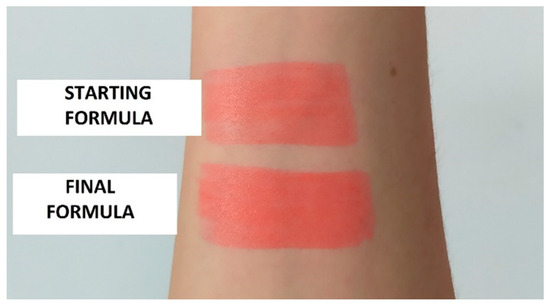
Figure 6.
Starting Formula of Lipstick vs. Ref. 1/21/18 (Final formula).
4.3. Sensory Evaluation after Application
This paragraph reports the sensory evaluations carried out for the formulated lipsticks by an expert panel, consisting of four subjects. Due to the small number of evaluators, the evaluation scale was highly reduced. In particular, we compared:
- Starting formula (Formula 1) vs. Ref. 1/21/1B (Formula 2, with 15% of the new oil)
- Starting formula (Formula 1) vs. Ref. 1/21/18 (Formula 3, with all fine adjustments).

Table 13.
Evaluation of the initial formula vs. Ref. 1/21/1B.

Table 14.
Evaluation of the initial formula vs. Ref. 1/21/18 (final formula).
The introduction of the new oil gives the lipstick a greater covering effect, with a smoother sensation on the lips and a more homogeneous mark. A numerical value is assigned to the judgments expressed for each parameter, obtaining the following scale: 1 = Inadequate; 2 = Poor; 3 = Fair; 4 = Good; 5 = Excellent
The results are shown in Figure 7.
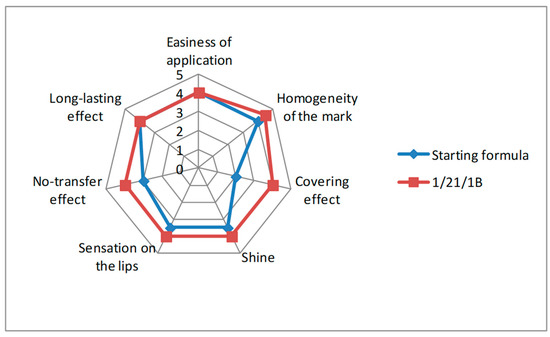
Figure 7.
Initial formula vs. Ref. 1/21/1B (with 15% new oil).
The final formula Ref. 1/21/18 shows a higher covering effect, with a more homogeneous and shiny mark, giving a smoother and softer sensation on the lips. The sensorial results are shown in Figure 8.
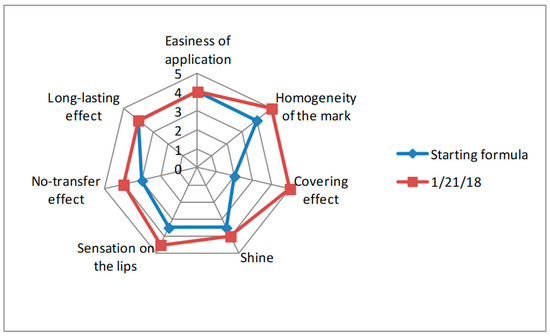
Figure 8.
Initial formula vs. Ref. 1/21/18 (final formula).
5. Conclusions
The study conducted in order to understand the formulation strategy necessary to use a new vegetal oil that could help develop a new lipstick formula allows to underline the following aspects:
- The new ingredient showed good compatibility with the tested waxes;
- gels obtained with 10% of Cera Alba, Candelilla Cera, Ozokerite, Cera Microcristallina and Stearyl Dimethicone in the test oil did not show syneresis over time;
- at 25% wax in the oil, no gels showed syneresis;
- good thickening effect observed with Candelilla Cera and Copernicia Cerifera Cera;
- the new oil does not have pigment-wetting properties comparable to castor oil; however, with titanium dioxide and the tested lake, it was possible to obtain homogeneous and quite fluid dispersions;
- the introduction of the new oil in a lipstick leads to improvements in terms of homogeneity of the mark, shine, and covering effect;
- it was possible to obtain a softer and smoother sensation on the lips by making some small additional changes to the developed formula.
Author Contributions
Conceptualization, L.R. and M.M.; methodology, L.R. and M.M.; validation, L.R.; formal analysis, M.M.; investigation, L.R. and M.M.; resources, L.R. and M.M.; data curation, L.R. and M.M.; writing—original draft preparation, L.R. and M.M.; writing—review and editing, L.R. and M.M.; supervision, L.R.; project administration, L.R. All authors have read and agreed to the published version of the manuscript.
Funding
This research received no external funding.
Institutional Review Board Statement
Not applicable.
Informed Consent Statement
Not applicable.
Conflicts of Interest
The authors declare no conflict of interest.
References
- Martin, M.; Rieger, P.D. Harry’s Cosmetology, 8th ed.; Chemical Publishing Co., Inc.: New York, NY, USA, 2000; pp. 543–558. [Google Scholar]
- Sandewicz, R.; Finkenauer, G. Lipstick. In Chemistry and Manufacture of Cosmetics, 4th ed.; Schlossman, M.L., Ed.; Allured Business Media: Carol Stream, IL, USA, 2009; Volume II–Formulating, pp. 433–456. [Google Scholar]
- Sulenta, T. Lipstick Formulation: Not as Easy as You Might Think; Personal Care Europe: Tunbridge Wells, UK, 2015; pp. 48–50. [Google Scholar]
- Bonté, F.; Cantin, H.; Heusèle, C. Lips and Lipstick. In Cosmetic Dermatology: Products and Procedures, 2nd ed.; Draelos, Z., Ed.; John Wiley & Sons, Ltd.: Chichester, UK, 2016; pp. 193–197. [Google Scholar]
- Riley, P. Colouring materials used in decorative cosmetics and colour matching. In Poucher’s Perfumes, Cosmetics and Soaps, 10th ed.; Butler, H., Ed.; Springer: Dordrecht, The Netherlands, 2000. [Google Scholar]
- Tavernier, I.; Doan, C.D.; Van de Wallea, D.; Danthinec, S.; Rimauxd, T.; Dewettincka, K. Sequential crystallization of high and low melting waxes to improve oil structuring in wax-based oleogels. RSC Adv. 2017, 7, 12113–12125. [Google Scholar] [CrossRef] [Green Version]
- O’Lenick, A.; Rhein, L.; Somasundaran, P.; Schlossman, M. Surfactants in Personal Care Products and Decorative Cosmetics, 3rd ed.; Taylor & Francis Inc.: Abingdon-on-Thames, UK, 2007. [Google Scholar]
- Agbo, C.; Jakpa, W.; Sarkodie, B. A Review on the Mechanism of Pigment Dispersion. J. Dispers. Sci. Technol. 2017, 39, 874–889. [Google Scholar] [CrossRef]
- Wiechers, J.M.; Barlow, T. Skin Moisturisation and Elasticity Originate from at Least Two Different Mechanisms. Int. J. Cosmet. Sci. 2001, 21, 425–435. [Google Scholar] [CrossRef] [PubMed]
- Hunt, C.; Lin, W.; Voulvoulis, N. Evaluating alternatives to plastic microbeads in cosmetics. Nat. Sustain. 2021, 4, 366–372. [Google Scholar] [CrossRef]
- McPhee, D.; Pin, A.; Kizer, L.; Perelman, L. Deriving renewable squalane from sugarcant. Cosm. Toil. 2014, 129, 20–26. [Google Scholar]
- Azeez, M.A.; Bello, O.S.; Adedeji, A.O. Traditional and medicinal uses of Luffa cylindrica: A Review. J. Med. Plants 2013, 1, 102–111. [Google Scholar]
Publisher’s Note: MDPI stays neutral with regard to jurisdictional claims in published maps and institutional affiliations. |
© 2021 by the authors. Licensee MDPI, Basel, Switzerland. This article is an open access article distributed under the terms and conditions of the Creative Commons Attribution (CC BY) license (https://creativecommons.org/licenses/by/4.0/).